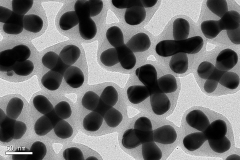Fashion house VERSACE has been captivated by the intrinsic beauty of nanoparticles of gold, a metal whose deep color has been a hallmark of the luxury brand since its inception. VERSACE has published an editorial project on social media inviting people to reflect on the concept of beauty on different scales, in somewhat unconventional ways and in unexpected places, and claims that scientific images often possess a hidden beauty that escapes the public eye. This project presented as an “experimental series with unexpected collaborators” has been designed as an exploration of hidden beauty and serendipity.
VERSACE has published images of gold nanoparticles synthesized in the CIC biomaGUNE laboratories led by Ikerbasque Research Professor Luis Liz-Marzán and at the University of Vigo. The project is based on a set of images revealing another side of the beauty of gold; they were produced by electron microscopy at the above institutions and in the laboratory of Professor Sara Bals at the University of Antwerp (Belgium).
Laura Tripaldi, science communicator and PhD graduate in Materials Science and Nanotechnology, is the person who has made this union between the world of fashion and nanoscience possible. Tripaldi is the author of an article on the history and properties of gold colloids (gold nanoparticles dispersed in a liquid), which has seen the light of day in this creative project curated and published by VERSACE. In that quest she chanced upon the CIC biomaGUNE images on the website of the European project EUSMI, a consortium that brings together European soft matter research facilities.
The beauty of gold nanoparticles with biomedical applications
Gold nanoparticles comprise a few thousand atoms and are of nanometric size (one nanometer is equivalent to one millionth of a millimeter). As the Versace’s initiative explains, the properties of materials change depending on their size as they shift from the macroscale to the nanoscale. Tripaldi also added that “the color of the material changes depending on the size and shape of the particles that comprise it, despite the fact that the substance itself remains the same”.
“A gold nanoparticle is made up of gold atoms in its crystalline structure, which needs to have molecules absorbed on its surface so that they can be dispersed in a liquid, i.e. to form a colloid,” explained Professor Luis Liz-Marzán, a pioneer in the development of methods for fabricating and modifying the surface of gold and silver nanoparticles to improve their application possibilities.
Liz-Marzán works on the growth designs of many types of nanoparticles, in the shapes of stars, rods, triangles, spheres, screws, cubes, octahedrons, decahedrons, bones, bipyramids, wires, etc. His publications have achieved worldwide renown for the relevance of their content. In fact, the professor explained that “by modifying the geometry of the nanoparticles, their plasmonic optical properties can be changed at will. Light interacts with these particles differently compared with metals that are of a larger size: depending on the metal, the size and geometry of the metal nanoparticle, a specific color of the light causes the electrons to oscillate, so that it absorbs a specific frequency of visible light”.
VERSACE stressed that the chameleon-like beauty of gold changes with scale, revealing unexpected facets the deeper one looks. Professor Liz-Marzán also highlighted the huge importance of these nanoparticles that have such surprisingly regular shapes, are of uniform size, have a perfectly geometric appearance, and are spontaneously arranged in beautiful, regular patterns: “They have applications in many, many fields of health, such as the specific and highly sensitive detection of metabolites involved in communication between bacteria, in tumor systems, etc., where the distribution of cells in a three-dimensional system is accurately detected in order to distinguish between tumor cells and healthy ones; or in bioimaging applications for nanomedicine.”
Liz Marzán continues to modify “the allure of gold in the nanoworld, because it is going to open unexpected doors to us in the design of more effective therapeutic methods and in achieving long-awaited personalized medicine”. VERSACE invites one to “look deeper” and reminds one that “beneath the surface there often lies a world of hidden beauty and profound meaning”.


